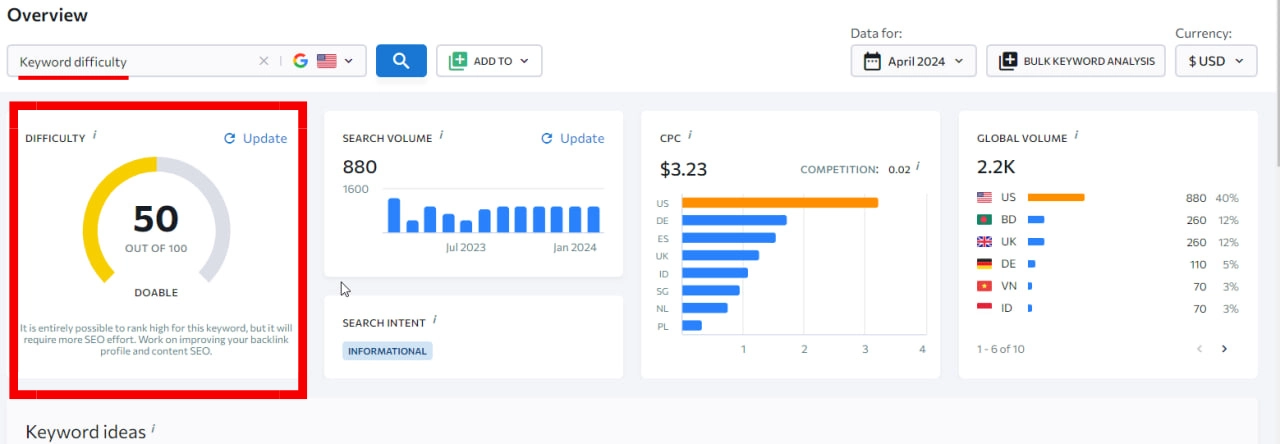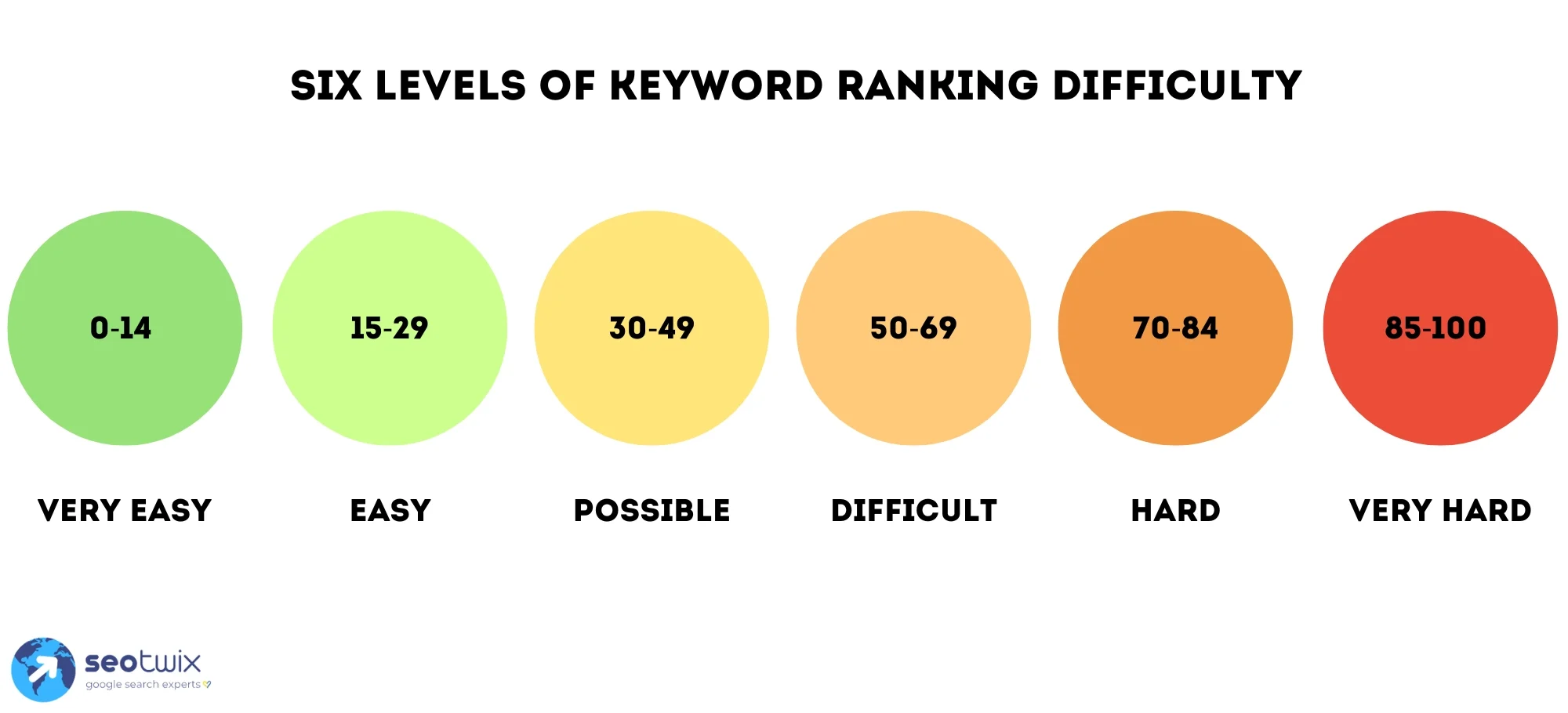In the realm of search engine optimization (SEO), understanding various metrics is crucial for developing a successful strategy. One such metric is keyword difficulty. This measurement plays a pivotal role in assessing how challenging it will be to rank for a particular keyword. By grasping the concept of keyword difficulty, you can make informed decisions about your SEO efforts and target keywords more effectively.
What is Keyword Difficulty?
Keyword difficulty measures how challenging it is to secure a top position for a specific keyword in search engine results pages (SERPs). This measure is influenced by several factors, including the level of competition among other websites targeting the same keyword and the strength of their SEO efforts. Essentially, keyword difficulty provides insight into the SEO difficulty associated with a keyword, helping you gauge whether it is worth pursuing.

Why is Understanding Keyword Difficulty Important?
Understanding keyword difficulty is crucial for several reasons. First, it allows you to prioritize your SEO efforts by focusing on attainable keywords based on your website’s current authority and resources. By evaluating what is keyword SEO difficulty for your target keywords, you can avoid wasting time and resources on highly competitive terms that may be difficult to rank for. Instead, you can target keywords with a more manageable level of difficulty, increasing your chances of achieving higher rankings and driving more organic traffic to your site.
How Does Keyword Difficulty Affect SEO?
Keyword difficulty has a direct impact on your SEO strategy. If a keyword has high difficulty, it indicates that achieving a top position in search results will require significant effort and resources. This may involve creating high-quality content, building backlinks, and optimizing on-page elements to compete with established sites. On the other hand, targeting keywords with lower difficulty can yield faster results and a higher return on investment (ROI). Thus, understanding keyword difficulty in SEO helps you allocate resources more efficiently and craft a strategy tailored to your website’s strengths and limitations.
Understanding the Optimal Keyword Difficulty Score
The perfect keyword difficulty score depends on factors such as your website’s authority, the level of competition, and your specific SEO objectives.
However, here are some general guidelines to help you determine what score might be considered “good”:
- Low Difficulty (0-30): Keywords within this range typically present less competition, making it easier to achieve higher rankings. If your website is new or has a lower domain authority, targeting keywords with a difficulty score in this range can be a strategic way to build your SEO presence and start driving traffic.
- Medium Difficulty (31-60): Keywords with medium difficulty require a moderate level of effort and resources to rank for. These keywords are often a good target once you’ve established some authority and have a solid SEO foundation. They find the sweet spot between competition intensity and traffic potential.
- High Difficulty (61-100): Keywords in this range are highly competitive and usually dominated by well-established websites with high authority. Ranking for these terms can be challenging and may require substantial SEO efforts, including high-quality content, strong backlinks, and extensive on-page optimization. These keywords might be suitable for more experienced sites with significant SEO resources.
To develop an effective SEO strategy, focus on targeting keywords that match your site’s existing authority and resources. Starting with lower to medium-difficulty keywords can provide quicker wins and help build the foundation needed to tackle more competitive terms over time.
What Tools to Use to Determine Keyword Difficulty
You can use a range of tools to evaluate keyword difficulty and gain insights into how competitive your target keywords are. Popular tools include:
- SEMrush: Provides detailed keyword difficulty scores along with competitive analysis.
- Ahrefs: Offers a comprehensive view of keyword difficulty and SERP competition.
- Moz: Includes a Keyword Difficulty tool that evaluates the level of challenge in ranking for specific terms.
- Ubersuggest: Offers insights into keyword difficulty along with keyword suggestions and comprehensive SEO analysis.
These tools can help you analyze the “SEO difficulty meaning” and make data-driven decisions about your keyword strategy.
How Keyword Difficulty is Calculated
Understanding how keyword difficulty is calculated involves delving into the metrics and algorithms used by SEO tools to assess the competitiveness of ranking for a specific keyword. While each SEO tool might have its proprietary method for calculating this metric, they generally analyze similar factors to gauge how hard it will be to rank on the first page of search engine results. Let’s outline the core components that typically go into calculating keyword difficulty.
Analysis of Backlinks
One of the primary factors considered is the quality and quantity of backlinks leading to the pages currently ranking for the keyword. Backlinks are seen as endorsements from one site to another;a page with a high number of quality backlinks is often viewed as a credible source by search engines and, thus harder to outrank.
- Quality of Backlinks: Links from authoritative, relevant sites carry more weight than those from lesser-known, irrelevant sites.
- Quantity of Backlinks: A higher number of backlinks might indicate that the page is a valuable resource, but it’s the combination of quality and quantity that’s crucial.
Page Authority and Domain Authority
Page Authority (PA) and Domain Authority (DA) are metrics developed to predict how well a specific page or entire domain will rank on SERPs. Tools that calculate keyword difficulty often consider these metrics to evaluate the strength of the competition.
- Page Authority: evaluates a page’s potential to rank well in search engine results, serving as a gauge of its ranking power.
- Domain Authority: Measures the overall strength of the entire domain or website.
Content Quality and Relevance
The relevance and quality of content on the pages that are currently ranking for the keyword also play a significant role. If the top results are well-written, comprehensive, and closely aligned with the search intent behind the keyword, the difficulty score increases. This is because outranking these pages would require producing content that is even more relevant and of higher quality.
Search Intent Alignment
The degree to which current top-ranking pages meet the search intent behind the keyword affects difficulty. Search intent refers to what the searcher is looking for informational content, a specific website, or a product to buy. If the top-ranking content aligns well with search intent, it sets a high bar for new content to compete.
User Engagement Metrics
Some SEO tools might also consider user engagement metrics like click-through rates (CTR), bounce rates, and time on site to estimate how satisfied users are with the current top-ranking pages. High satisfaction levels could indicate a more challenging environment for new entrants.
Competitor SEO Metrics
Lastly, an analysis of the SEO metrics of the competitors ranking for the keyword, such as their use of the keyword in titles, meta descriptions, and H1 tags, as well as their site speed and mobile-friendliness, can influence the keyword difficulty score.
Remember, SEO is not just about picking the right keywords; it’s about creating quality content that answers your audience’s questions and needs. Combine smart keyword selection with stellar content, and you’re well on your way to SEO success.





